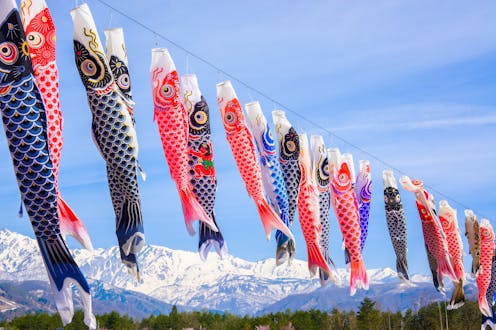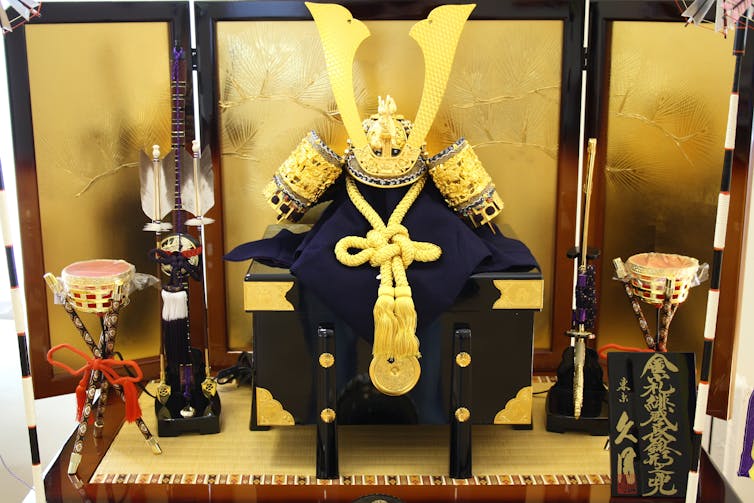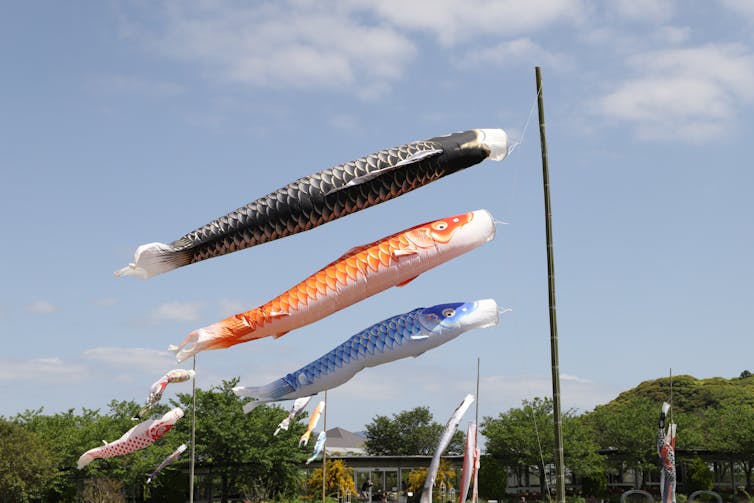
In Japan, Children’s Day – Kodomo no Hi – is held on May 5 and marks the final national holiday of the period known as Golden Week. This is a series of national holidays that allows Japanese people to take the best part of a week off to travel, visit family, and spend money.
The purpose of Children’s Day is to “honour the character of children, emphasise their welfare and give thanks to mothers”. It is most famously signified by the Koi Nobori – carp streamers – which adorn houses, shopping streets and local parks.
These streamers celebrate the perseverance, vitality, and health of young Japanese boys. Because, despite the name, Children’s Day is usually considered as a festival of boys, the counterpart to the Dolls Festival (Hina Matsuri), held every year in March to celebrate the health and wellbeing of girls.
Children’s Day was established in 1948, as one of several national holidays formalised by Japan’s Public Holiday Law. However, it has a much longer history.
In 7th century Japan, the Tango no Sekku (Iris Festival) was established on the fifth day of the fifth month as one of the five festivals to mark the changing of the seasons.
From around the 11th century, the rural customs of hanging iris leaves (shobu) and another plant, yomogi, under the eaves of farmhouses, as well as eating rice cakes wrapped in oak leaves – both to ward off evil spirits and protect against fire and illness – became associated with Tango no Sekku.

From the Kamakura period (1192-1333), Tango no Sekku became increasingly important for powerful samurai families who began to adorn their houses not just with the traditional, sword shaped iris leaves, but also with armour and helmets. This tradition mirrored the presentation of replica suits of armour to local shrines in return for divine protection.
The Japanese characters for “martial spirit” (尚武) and iris leaves (菖蒲) are both pronounced shobu, making a connection between the iris leaves and valour, vitality and strength. As the political and military power of the samurai increased, the festival gradually came to be associated with the desire for a strong heir and continuing prosperity for the clan.
Today, an important, and expensive, part of the Children’s Day celebration is the display of a samurai helmet or warrior doll presented to baby boys, usually by the maternal grandparents.

By the Tokugawa period (1603-1868), the association between the Iris Festival and the health and prosperity of the male offspring of samurai families helped to create a clear distinction between Tango no Sekku as “boys day”, and the March festival of Hina Matsuri as “girls day”. Hina Matsuri, also one of the five seasonal festivals, became an opportunity to pray for the growth, prosperity and happiness of girls under the age of ten and their prospects for marriage.
Around this time too, merchant families began to display carp streamers outside their houses as symbols of health and vitality. This is in reference to a Chinese legend in which a carp transforms into a dragon.
A new direction
However, Japan’s defeat and occupation in 1945 led to a reconsideration of national symbols. This was a period when old concepts and ideas had to be repackaged and reformulated to reflect an emphasis on peace, equality, and democracy as well as a rejection of militarism in all its forms.
In 1948, when the holiday was formalised as Children’s Day, there was a clear desire to create a holiday to celebrate children as part of families, the state, and society, and to move away from the patriarchal past by celebrating the role of mothers.
Before 1945, a large black carp streamer and a smaller red and yellow one were flown to symbolise father and son. But by the 1950s, the smaller red and yellow carp streamer came to be understood as representing the mother, and a smaller blue streamer was added to symbolise younger siblings, allowing the Koi Nobori to neatly represent the ideal post-war Japanese family.

The importance and popularity of Kodomo no Hi is an indication of the durability of family ties, constant concern for the welfare of children, and the never ending invention of tradition.
Martyn Smith does not work for, consult, own shares in or receive funding from any company or organisation that would benefit from this article, and has disclosed no relevant affiliations beyond their academic appointment.
This article was originally published on The Conversation. Read the original article.







